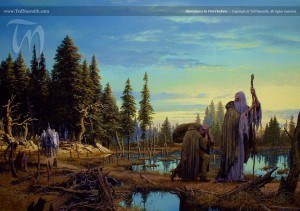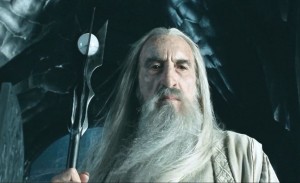The lure of the Rings of Power… and the One

In T.A. 2850, Gandalf confirmed that Sauron, truly, had returned and was inhabiting the dark fortress in southern Mirkwood. Yet the following year, when the Council met in T.A. 2851, Saruman overruled any decision to take action against the gathering shadow. He “counselled them to wait yet and to watch,” invoking the age-old belief that the One fell from Isildur’s grasp into Anduin, and thence was carried to the Sea never to be found again (S 301). Saruman, living up to his name, was ever cunning; certainly, he was too wise for such sophistry, as were the rest of the Council.
Yet, 2851 marks a decisive moment in the history of Middle-earth, for it is at this time, that Saruman, at that very meeting, formally and unequivocally turned from friend to foe. None could read Saruman’s game, though it was cleverly designed. When he assured the Council that no war should be brought on Dol Guldur, it was for one express purpose: to let Sauron draw out the Ring. He believed that if Sauron’s power waxed, “the Ring…would seek for its master” and that “if [Sauron] were driven out again, it would lie hid” (S 301). He, thus, hoped to “forestall both his friends and the Enemy,” and in swift deception take the Ring for his own (S 301).
This decision sealed Saruman’s fate and that of Middle-earth; it marked out a traitor one who could have been of valiant aid, and it spelled the doom of many. Passing this junction, Sauron, as much as Gandalf, was held as a rival by Saruman. And with each move the Enemy took to find the One, Saruman countered, searching far and wide, learning more and more of the lore of the Rings—indeed, he perhaps knew more than any other of that lost history save Sauron himself.
So, finally in T.A. 2941, Saruman consented to attack Dol Guldur, wishing to prevent Sauron from searching the River, and fearing ever that the Enemy was closer to the Ring than he. This was the last time he ever aided the Council—though, truly, it was for his own gain and peace of mind (S 302).
 If the critical transition in Saruman’s betrayal comes at T.A. 2851, when he takes a categorically definitive ideological turn down the path of traitor, how are we to interpret his line from the recent trailer? At this point in the film, on the cusp of the Battle of the Five Armies, it is already the year T.A. 2941; the very year in which the White Council assails Dol Guldur. So, what does Saruman mean when he says, “Leave Sauron to me?” Certainly, Saruman did not attack the fortress alone (and, as it turned out, Sauron had fled beforehand anyways); and, certainly, he cannot be referencing the contact he would maintain with Sauron almost sixty years later.
If the critical transition in Saruman’s betrayal comes at T.A. 2851, when he takes a categorically definitive ideological turn down the path of traitor, how are we to interpret his line from the recent trailer? At this point in the film, on the cusp of the Battle of the Five Armies, it is already the year T.A. 2941; the very year in which the White Council assails Dol Guldur. So, what does Saruman mean when he says, “Leave Sauron to me?” Certainly, Saruman did not attack the fortress alone (and, as it turned out, Sauron had fled beforehand anyways); and, certainly, he cannot be referencing the contact he would maintain with Sauron almost sixty years later.
One thing is certain: this line evinces Saruman’s enduring commitment to getting the Ring for himself. While he may have passed the crossroads at 2851, the process of Saruman’s corruption continued for many years, only reaching completion around T.A. 3000, when he is consumed by the will of Sauron.
The story of Saruman’s descent to evil spans across many years and many volumes, a complex web of deceit and mystery. Tracing the course of this betrayal, one comes eventually to the words of Gandalf near the end of The Lord of the Rings.
When Gandalf says that he is Saruman, or Saruman “as he should have been,” an echo of this distant past decision is heard. Whereas, at the crossroads of 2851, Gandalf turned one way, Saruman turned the other, truly departing from the path of wisdom.
Tedoras is a bibliophile, linguist, and regular attendee at TORn’s live weekly webcast. He splits his time between scouring the web for Tolkien books to add to his collection and the study of Chinese politics and public policy.


